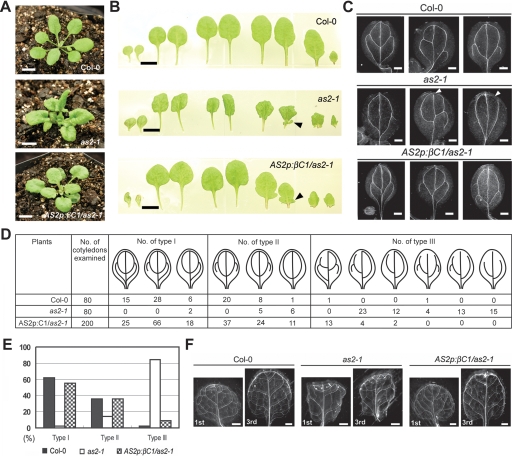Figure 5.
Partial complementation of as2 by AS2p:βC1. (A, B) Phenotypes of 21-d-old wild-type Col-0, as2-1 and AS2p:βC1/as2-1 transgenic plants. (A) Leaves in AS2p:βC1/as2-1 were flatten and rounder compared with the downward-curled leaves with plump and humped lamina at the leaf base of as2-1. (B) Morphology of cotyledons and rosette leaves. (From left to right) Two cotyledons, first two rosette leaves, second two rosette leaves, third two rosette leaves, and fourth two rosette leaves. Arrowheads indicate leaf lobes. (C–F) Venation patterns of 12-d-old cotyledons and 21-d-old rosette leaves in wild-type Col-0, as2-1 and AS2p:βC1/as2-1 transgenic plants. (C) Dark-field images of venation patterns in cotyledons. Wild-type Col-0 showed 2-4 loops with connection between primary and secondary veins. as2-1 showed 0-2 loops with connection defects in primary and secondary veins. AS2p:βC1/as2-1 transgenic plants showed wild-type venation patterns. Arrowheads indicate connection defect. (D) Patterns of veins were classified into three types according to the number of loops and connection defects in primary and secondary veins. In wild-type Col-0 and AS2p:βC1/as2-1, the largest population contained three loops with five NBPs. In as2-1, the largest population contained one loop with four NBPs and had connection defects. (E) Summary of the distribution of venation patterns in D. The percentage of each venation type in wild-type Col-0, as2-1 and AS2p:βC1/as2-1 was shown in bars with different shades. (F) Dark-field images of venation patterns in first and third rosette leaves. Bars: A,B, 5 mm; C, 0.25 mm; F, 1 mm.

